Posts Tagged: Botrytis
Presentations from Last Week's Botrytis Meeting
For those of you who might have missed it, the presentations of last week's UCCE - CalPoly Strawberry Center are posted here. Just speaking for the Watsonville event, we had a seriously large SRO crowd that read like a who's who of the industry with lots of enthusiasm with plenty of participation.
Just a side note here, but a good number of people commented to me later on that they really got something out of this single topic format. I hear you loud and clear, and going forward to will look to do more of these.
New Guidelines for Botrytis Fruit Rot in Strawberry Now Available
Very nice set of guidelines for Botrytis fruit rot in strawberry that Steve Koike and I wrote up as an expansion of a blog post we wrote a few years ago. Thanks to Joy Jacobs of the California Strawberry Commission, we now have them available for you in a beautiful full color format.
Download, print, use as you wish, this is the latest word in Botrytis management for berry growers.
Botrytis Fruit Rot of Strawberry - 2016
Fungicide Trials for Fruit and Foliar Pathogens of Strawberry 2013-2014
Summary: In 2014, the authors evaluated fungicide products against a slate of several registered fungicides and an untreated control. Fungicides were tested for efficacy against gray mold caused by Botrytis cinerea and powdery mildew caused by Podosphaera aphanis.
Introduction: The authors have been engaged in studying fruit and foliar pathogens in strawberry since 2007. While this group of pathogens includes anthracnose caused by species of Colletotrichum, leather rot caused by Phytophthora cactorum and angular leaf spot caused by Xanthomonas fragariae, the fungicide screening of 2014 concentrated on the two most common problems: gray mold caused by Botrytis cinerea, and powdery mildew caused by Podosphaera aphanis. Year after year these diseases are the most important foliar/fruit concerns for growers, and subsequently garner the most attention from fungicide distributors and manufacturers.
Materials and Methods:
Powdery Mildew: The trial consisted of treatments (Table 1) arranged in a randomized complete block design with each treatment replicated four times, on the Holly Ranch managed by Dole on the variety Monterey. Applications of all materials were made in the equivalent of 150 gallons per acre with a motorized backpack sprayer and hand held boom configured with ten 8001 flat fan nozzles operating at 120 psi, which is intended to closely mimic the conditions of commercial application. Applications of all materials were made two weeks apart: May 16, May 28, June 16, and June 24, 2014.
Powdery mildew evaluations were done on June 5, June 19 and July 7 and consisted of taking ten strawberry leaflets (per plot) of young to mid-age and assigning a percentage on a scale of 0-100% (in 10% increments) to the level of powdery mildew severity on the underside.
Table 1: 2014 Powdery Mildew Treatments
|
|
Test Material |
Rate/acre |
|
Thiram 24/7 |
2.6 qt |
|
|
Thiram 24/7 2.6 qt+ Procure 480 SC |
8 fl oz |
|
|
Thiram Granu-Flo |
4.4 lb |
|
|
Pyriofenone |
4 fl oz |
|
|
Pyriofenone |
5 fl oz |
|
|
Pyriofenone 4 fl oz + Quintec |
6 fl oz |
|
|
Quintec |
6 fl oz |
|
|
Rally |
5 oz |
|
|
Rally 5 oz w/ Quintec |
5 fl oz |
|
|
Merivon + Nufilm P |
8 fl oz + 0.01% v/v |
|
|
Merivon + Nufilm P |
10 fl oz + 0.01% v/v |
|
|
Pristine |
23 oz |
|
|
Torino 3.4 fl oz w/ Mettle |
5 fl oz |
|
|
Isofetamid |
17 fl oz |
|
|
Isofetamid + IB8111 |
10.3 fl oz + 5.57 fl oz |
|
|
Isofetamid + 18121 |
10.3 fl oz + 16.5 fl oz |
|
|
Isofetamid + IB18220 |
10.3 fl oz + 7.6 fl oz |
|
|
Untreated check |
- |
Results for 2014 Trial
Table 2: 2014 Powdery Mildew Evaluation- Percent Leaf Disease by Treatment
|
Character Rated |
% Infest |
% Infest |
% Infest |
||||
|
Rating Date |
Jun-5-2014 |
Jun-19-2014 |
Jul-7-2014 |
||||
|
Number of Decimals |
2 |
2 |
2 |
||||
|
Trt |
Treatment |
|
|
|
|
|
|
|
Name |
1 |
2 |
3 |
||||
|
1 |
Thiram 24/7 2.6 qt |
23.44 |
a |
17.25 |
bcd |
23.08 |
abc |
|
2 |
Thiram 24/7 2.6 qt+ Procure 480 SC 8 fl oz |
11.88 |
cde |
7.25 |
gh |
14.64 |
def |
|
3 |
Thiram Granu-Flo 4.4 lb |
16.25 |
bc |
18.00 |
bc |
26.35 |
a |
|
4 |
Pyriofenone 4 fl oz |
13.44 |
cde |
13.00 |
def |
15.85 |
cde |
|
5 |
Pyriofenone 5 fl oz |
13.13 |
cde |
8.25 |
fgh |
8.90 |
fgh |
|
6 |
Pyriofenone 4 fl oz + Quintec 6 fl oz |
15.31 |
bcd |
11.25 |
efg |
13.60 |
d-g |
|
7 |
Quintec 6 fl oz |
15.00 |
bcd |
15.50 |
b-e |
23.55 |
ab |
|
8 |
Rally 5 oz |
16.25 |
bc |
19.25 |
b |
29.40 |
a |
|
9 |
Rally 5 oz w/ Quintec 5 fl oz |
10.31 |
c-f |
14.00 |
cde |
17.26 |
bcd |
|
10 |
Merivon 8 fl oz + Nufilm P 0.01% |
6.88 |
ef |
4.25 |
h |
6.76 |
hi |
|
11 |
Merivon 10 fl oz + Nufilm P 0.01% |
3.75 |
f |
3.75 |
h |
3.49 |
i |
|
12 |
Pristine 23 oz |
21.25 |
ab |
13.00 |
def |
22.66 |
abc |
|
13 |
Torino 3.4 fl oz w/ Mettle 5 fl oz |
7.19 |
ef |
7.00 |
gh |
8.67 |
gh |
|
14 |
Isofetamid 17 fl oz |
11.88 |
cde |
8.75 |
gh |
11.47 |
d-h |
|
15 |
Isofetamid 10.3 fl oz + IB8111 5.57 fl oz |
10.63 |
cde |
11.75 |
efg |
15.71 |
cde |
|
16 |
Isofetamid 10.3 fl oz + 18121 16.5 fl oz |
11.94 |
cde |
4.75 |
h |
10.84 |
e-h |
|
17 |
Isofetamid 10.3 fl oz + IB18220 7.6 fl oz |
9.06 |
def |
7.25 |
gh |
10.98 |
d-h |
|
18 |
Untreated check |
20.94 |
ab |
24.75 |
a |
30.04 |
a |
|
LSD (P=0.05) |
6.768 |
4.920 |
0.838t |
||||
|
Standard Deviation |
4.786 |
3.479 |
0.593t |
||||
|
CV |
36.12 |
29.53 |
14.89 |
||||
Means followed by same letter do not significantly differ (P=0.05, LSD)
Botrytis Gray Mold: The trial consisted of treatments (Table 3) arranged in a randomized complete block design with each treatment replicated four times, on the Holly Ranch managed by Dole on the variety Monterey. Applications of all materials were made in the equivalent of 150 gallons per acre with a motorized backpack sprayer and hand held boom configured with ten 8001 flat fan nozzles operating at 120 psi, which is intended to closely mimic the conditions of commercial application. Applications of all materials were made two weeks apart May 16, May 28, June 16, and June 24, 2014.
Evaluations for Botrytis infected fruit were made during the weekly fruit harvest by a professional crew of research plot harvesters beginning May 21 and continuing until July 16. Culls were sorted and examined for symptoms and signs of gray mold disease, and a percentage of gray mold infected fruit was calculated from the total fruit harvested from that plot. Data results (Table 4) is presented as a percentage of Botrytis infected fruit from the total amount harvested.
Table 3: Test materials for Botrytis study
|
|
Test Material |
Rate/acre |
|
Thiram 24/7 |
2.6 qt |
|
|
Thiram 24/7 2.6 qt+ Procure 480 SC |
8 fl oz |
|
|
Thiram Granu-Flo |
4.4 lb |
|
|
Merivon + Nufilm P |
8 fl oz + 0.01% v/v |
|
|
Merivon + Nufilm P |
10 fl oz + 0.01% v/v |
|
|
Pristine |
23 oz |
|
|
Isofetamid |
17 fl oz |
|
|
Isofetamid + IB8111 |
10.3 fl oz + 5.57 fl oz |
|
|
Isofetamid + 18121 |
10.3 fl oz + 16.5 fl oz |
|
|
Isofetamid + IB18220 |
10.3 fl oz + 7.6 fl oz |
|
|
Untreated check |
- |
Table 4: Results for 2014 trial
|
Character Rated |
% Bot |
% Bot |
% Bot |
%Bot |
%Bot |
||||||
|
Rating Date |
Jun-4-2014 |
Jun-11-2014 |
Jun-18-2014 |
Jun-25-2014 |
Jul-3-2014 |
||||||
|
Treatment Name |
3 |
4 |
5 |
6 |
7 |
||||||
|
1 |
Thiram 24/7 2.6 qt |
4.21 |
a |
1.68 |
a |
3.15 |
ab |
8.75 |
a |
18.01 |
a |
|
2 |
Thiram Granuflo 4.4 lbs |
7.22 |
a |
1.07 |
a |
1.95 |
abc |
15.17 |
a |
18.39 |
a |
|
3 |
Thiram 24/7 + Procure 480 SC |
9.27 |
a |
2.49 |
a |
1.64 |
abc |
14.36 |
a |
16.198 |
a |
|
4 |
Merivon @ 8 fl oz |
5.52 |
a |
1.49 |
a |
0.74 |
c |
15.56 |
a |
16.268 |
a |
|
5 |
Merivon @ 10 fl oz |
5.96 |
a |
1.25 |
a |
0.69 |
c |
15.73 |
a |
17.233 |
a |
|
6 |
Pristine @ 23 oz |
7.46 |
a |
1.44 |
a |
3.49 |
a |
12.32 |
a |
14.708 |
a |
|
7 |
Isofetamid @ 17 fl oz |
6.54 |
a |
1.07 |
a |
1.67 |
abc |
12.70 |
a |
17.975 |
a |
|
8 |
Isofetamid @ 10.3 fl oz + IB8111 @ 5.57 fl oz |
5.67 |
a |
1.58 |
a |
1.35 |
bc |
10.86 |
a |
20.643 |
a |
|
9 |
Isofetamid @ 10.3 fl oz + IB18121 @ 16.5 fl oz |
4.69 |
a |
2.11 |
a |
2.63 |
ab |
8.60 |
a |
12.815 |
a |
|
10 |
Isofetamid @ 10.3 fl oz + IB18220 7.6 fl oz |
5.59 |
a |
1.85 |
a |
1.87 |
abc |
9.22 |
a |
19.803 |
a |
|
11 |
UTC |
13.52 |
a |
1.68 |
a |
3.14 |
ab |
7.66 |
a |
14.720 |
a |
|
LSD P=0.05 |
0.344t |
0.276t |
0.265t |
0.282t |
8.9782 |
||||||
|
Standard Deviation |
0.238t |
0.191t |
0.183t |
0.196t |
6.2180 |
||||||
|
CV |
27.11t |
46.46t |
39.85t |
17.79t |
36.62 |
||||||
Means followed by same letter do not significantly differ (P=0.05, LSD)
Discussion of Results for 2014 Trial:
Powdery Mildew: Control of powdery mildew by both rates of Merivon and a rotation of Torino and Mettle was exceptional, with percentages of infection significantly lower than many treatments in each of the three evaluation dates.
Looking at the last rating date on July 7, neither formulation of Thiram controlled powdery mildew, but the inclusion of Procure together with Thiram 24/7 did result in disease percentages below the untreated control. Test compounds isofetamid and pyriofenone had lower percentages of mildew than the untreated control. Rally 40W did not have significantly lower percentages of mildew than the untreated control.
Botrytis: With the exception of the June 18 evaluation date, no significant differences were found between any of treatments. On June 18, both treatments of Merivon demonstrated lower levels of Botrytis infected fruit than the untreated control, Thiram 24/7, isofetamid @10.3 fl oz + IB8111 and Pristine.
Final Note: The use of fungicides, including unregistered materials, is the topic of this article. Before using any of these products, check with your local Agricultural Commissioner's Office and consult product labels for current status of product registration, restrictions, and use information.
Acknowledgments.
We thank Patty Ayala, Kat Kammeijer and Monise Sheehan for their assistance with this trial. We acknowledge the California Strawberry Commission and cooperating companies, in particular Dole, for supporting this work.
A Treatise on Botrytis Diseases of Strawberry and Caneberry
Introduction: A major purpose of this blog is to educate and inform on new emerging issues and developments in strawberries and caneberries. In addition, we also want to review and update common, well known issues that readers may be very familiar with. The following article is a review of a very important disease affecting the strawberry and caneberry industries: gray mold caused by Botrytis cinerea.
Causal Organism: Botrytis cinerea belongs to the fungal phylum Deuteromycota (sometimes also known as fungi imperfecti) and reproduces by forming asexual spores (conidia). The sexually reproducing stage has not been seen on strawberry or caneberry. The young mycelium of this fungus is septate, branched, and basically colorless. When this fungus is grown on potato dextrose agar, a common medium used to culture fungi, Botrytis cinerea is at first white and later turns gray as spores form. The spore producing structures are branched, up to 5 mm tall, and light to dark gray in color. Even under the low magnification of a dissecting microscope, one can readily see the distinctive “botryose” (Greek for bunch of grapes) clusters of spores at the ends of the spore-bearing branches (see sixth picture below).
Symptoms on Fruit: The rot from Botrytis is fairly simple to distinguish from the other fruit rots occurring in strawberries and caneberries. Generally, Botrytis rot will start as a light brown to gray spot (see third photo below) without any distinct margin around the affected area. This spot remains firm as it spreads and even a fruit completely rotten with Botrytis will retain its original shape. After a few days, if conditions are favorable (temperatures between 59o- 77oF), a brown to gray velvety growth will appear on the surface of the infected fruit.
Disease Cycle: Botrytis fruit infections on the Central Coast generally begin when the spore lands on the strawberry or caneberry flower. Given cooler temperatures and the presence of water, the spore germinates and infects the flower. If conditions are really favorable, the disease will progress in flower tissues and result in blighted blossoms that will no longer develop into fruit. Partial flower infections can cause brown lesions to form on the fruit receptacle; such flowers will not produce normal, fully developed fruit. In other cases the flower-invading Botrytis can become dormant and will not resume growing until fruit sugar content is more amenable for growth, at which point the disease will become evident from the brown lesion and subsequent gray velvety growth that occurs on the ripening fruit. If conditions become unfavorable for further disease development, Botrytis growth will stop and the lesion will become dry and leathery.
Because Botrytis is an aggressive colonizer of plant wounds, direct infection of the fruit can also occur if the fruit is injured from physical abrasion (rubbing caused by winds, for example), insect feeding, environmental extremes, other diseases, and other factors. Mature, ripe fruit are especially susceptible to infection because of their high sugar content and sensitive tissues. For this reason, Botrytis is an important component of post-harvest fruit losses.
Epidemiology: Botrytis spores (primary inoculum) are everywhere. The fungus grows well on senescent, dead tissues (old, dead strawberry stems and leaves; crop residues of other adjacent crops). Spores are blown by winds or splashed by rains onto flower and fruit tissues. It is important to note that the presence of free moisture for several consecutive hours is necessary for spore germination. Therefore, development of gray mold disease is greatest in cool and wet conditions, such as rain and the fog commonly experienced here on the Central Coast.
Control: Growers and managers should take a threefold approach to managing Botrytis gray mold in the field.
Fungicides: There is a substantial universe of fungicides available for the management of gray mold in strawberries and caneberries and a decent listing of these materials is available at the UC IPM website (http://www.ipm.ucdavis.edu/PMG/crops-agriculture.html). The key point for disease managers is to apply fungicides BEFORE major moisture events. As emphasized above, Botrytis spores need free moisture to germinate; therefore fungicides, which mostly act as protectants,should be in place before the occurrence of humidity and free moisture from rain or heavy fog . It is worth noting that the use of surfactants, which serve to better distribute fungicides over the plant surface as well as stabilize them, is strongly recommended with fungicide applications.
Sanitation: Removal of infected fruit from around the plant during the harvest season is helpful in reducing Botrytis gray mold potential, since each infected fruit produces millions of spores that can move onto nearby flowers and fruit. It is not necessary to remove fruit completely from the field; deposition of diseased fruit into the furrow and its periodic destruction by foot or machine traffic is sufficient. Additionally, removal of dead leaves on occasion can be of benefit because it removes another potential source of inoculum while at the same time maintaining more air circulation around the plant and keeping it drier.
Moisture management: Knowing that free moisture is critical to development of Botrytis grey mold gives managers a key tool in limiting development of this disease. For strawberries, planting so as to account for expected plant size and allowing for more air circulation is one step. It is worth noting that transplants can be chilled with an eye to managing plant size; short day varieties such as Chandler and Camarosa should not be chilled more than three days for most situations, and day neutral varieties such as Albion, San Andreas or Monterey generally should not be chilled more than 18 days. The use of drip irrigation, a universal practice in California, is essential for preventing irrigation water from contributing to favorable conditions for gray mold disease.
The use of macro-tunnels (also called high tunnels or Spanish tunnels) in caneberries results in a tremendous reduction of free moisture from rain or dew and a very real drop in the amount of gray mold disease to the extent that fungicide applications for Botrytis might be dispensed with entirely. There is no bigger step a caneberry grower can take to reduce Botrytis gray mold in their crop than to construct a macro-tunnel over it.
Before using any fungicide products, check with your local Agricultural Commissioner's Office and consult product labels for current status of product registration, restrictions, and use information.
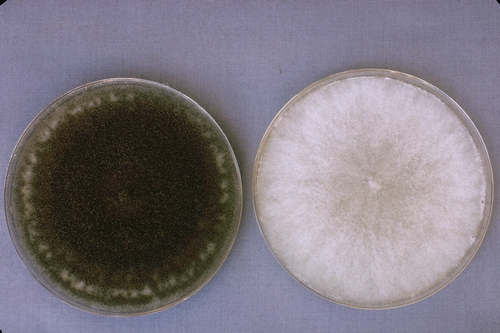
Botrytis cultures grown with light (left) and in complete darkness (right). Photo courtesy Steven Koike, UCCE
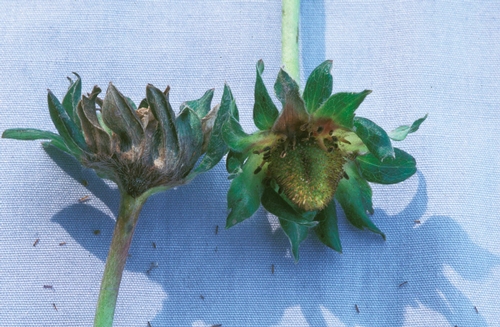
Gray mold lesions on calyces of developing fruit. Photo courtesy Steven Koike, UCCE.
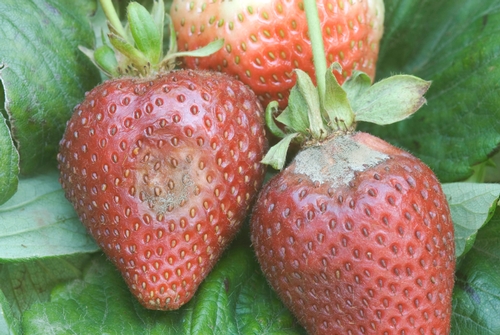
Early gray mold lesion on strawberry fruit. Photo courtesy Steven Koike, UCCE.
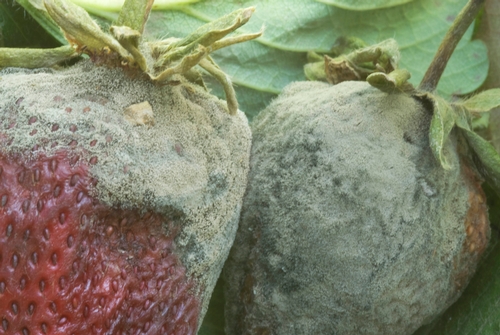
Extensive Botrytis sporulation on advanced gray mold of strawberry fruit. Photo courtesy Steven Koike, UCCE.
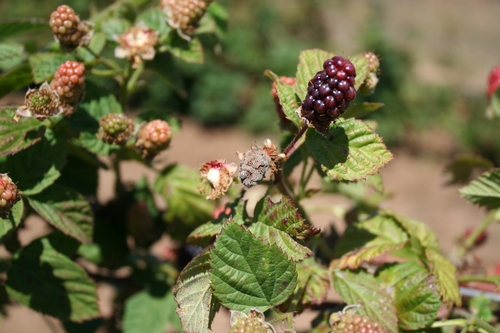
Botrytis infection on blackberry fruit. Fruit is desiccated and dried out. Photo Mark Bolda, UCCE Santa Cruz County.
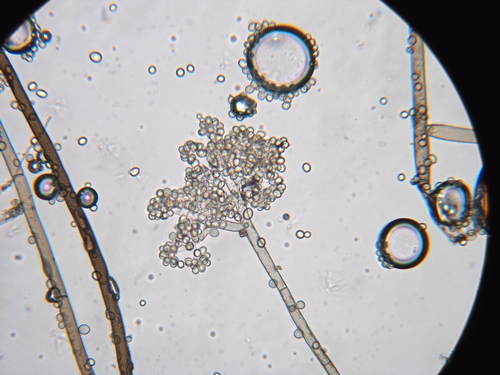
Clustered spores of Botrytis cinerea. Photo courtesy Steven Koike, UCCE.
Rhizopus and Mucor fruit rots in strawberry.
Two pathogens that strawberry growers face all year long but especially now during the fall are Rhizopus and Mucor, which both cause a fruit rot that is distinctive and very different from the more common gray mold fruit rot caused by Botrytis cinerea.
The fruit rot symptoms caused by Rhizopus and Mucor look very similar. Fruit infected with either of these pathogens become very soft and start to leak sticky red juices from the fruit tissues. In later stages of infection fruit softens to the point that it is no longer solid and cannot be picked up without falling apart. Affected fruit are usually covered with the wispy, fuzzy black and white growth of the pathogen. Both Rhizopus and Mucor fungi are fairly easy to distinguish from Botrytis gray mold. The Botrytis fruit infection does not substantially soften the fruit, extensive leaking of fruit juices does not occur, and Botrytis growth on strawberry fruit will be gray to tan in color.
While the fruit softening symptoms of Rhizopus and Mucor are similar, the two fungi can be distinguished from one another by examining the fungal growth with a hand lens. Look for the tiny, dark brown to black, spherical structures on the ends of the white fungal strands. These black spheres are the spore bearing structures, or sporangia. For Rhizopus the sporangia appear dry while the Mucor sporangia are wet or sticky looking due to a viscous liquid film. In addition, examine the general orientation or arrangement of the sporangia within the fungal growth. For Mucor the sporangia are usually lined up in parallel rows or stands. Sporangia of Rhizopus, however, appear randomly and are not found in any particular order or arrangement.
There are several ways to minimize the infection of fruit by Mucor and Rhizopus. Use plastic mulch and drip tape, like most strawberry growers are already doing, since they minimize contact of the fruit with soil and water. Practice good field sanitation by getting rotten fruit away from plant. Handle fruit in a way to minimize wounding, which opens an avenue for these fruit rots. Cooling fruit quickly after harvest is helpful to minimize spread and development of Rhizopus, since this pathogen is not very active below 40oF; conversely Mucor is less affected by cold temperatures and could slowly develop in storage.
As for fungicides, Captan and Switch are already known to be effective. Our annual fungicide evaluation experiments include a post-harvest component and provided additional information on fungicide efficacy against Rhizopus/Mucor. Ripe fruit were harvested from each treatment replicate, placed in a dry, open air box at room temperature, and evaluated for disease for several days. We found Pristine to be consistently good at suppressing both fruit rots.
Before using any fungicide product, check with your local Agricultural Commissioner's Office and consult product labels for current status of product registration, restrictions, and use information.
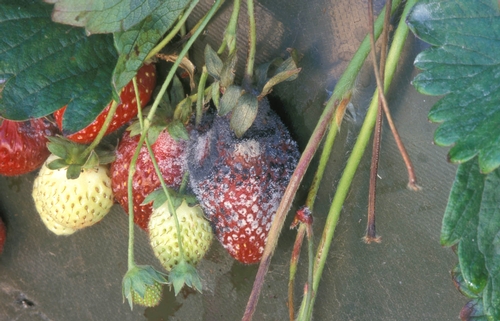
Photo courtesy Steven Koike, UCCE. Rhizopus rot on strawberry. Note the mature, black sporangia.
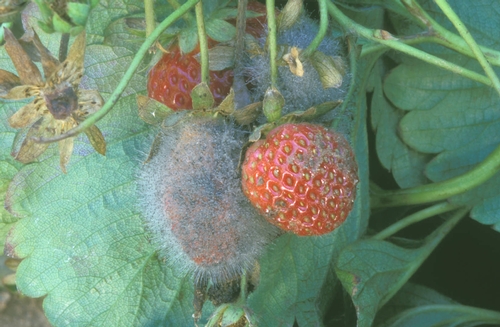
Photo courtesty Steven Koike, UCCE. Mucor rot on strawberry. Note sporangia which appear to be lined up in parallel rows or stands of this fungus.

